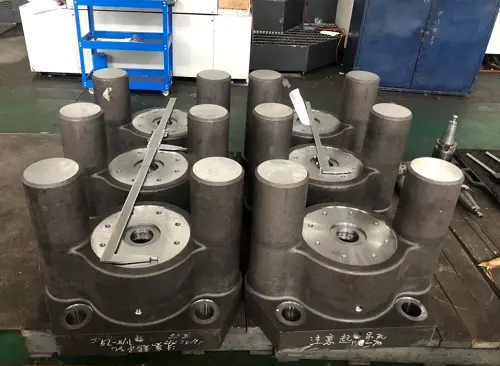
Knowledge
Introduction to Trace Elements in Ductile Iron ( Part Four)

Trace elements in ductile iron
During the manufacturing process of ductile iron, there are a series of trace elements that interfere with the spheroidization process. Although the mass fraction of these elements in ductile iron is only a few parts per ten thousand or a few parts per hundred thousand, they can significantly affect the spheroidization effect. This interference is closely related to the magnesium content in the melt and the cooling rate, and the effects of various interfering elements are superimposed.
Common interfering elements include Sb, Sn, Bi, Te, Pb, Ti, Se and As, etc. These elements can be classified according to their consumption characteristics of magnesium: Te and Se belong to magnesium-consuming type, which are prone to combine with magnesium and promote the formation of vermicular graphite, undercooled graphite and flake graphite; Sb, Sn, As and Ti belong to grain boundary segregation type, which tend to form distorted graphite at the grain boundaries; while Pb and Bi belong to the mixed type, forming distorted graphite at low content and promoting the formation of undercooled graphite and flake graphite at high content.
To suppress the anti-spheroidizing effect of these trace interfering elements or to broaden their allowable range, rare earth elements can be added to ductile iron. The addition amount of rare earth elements should be adjusted according to the purity of the molten iron, and it is usually appropriate for the residual cerium mass fraction to reach 0.03%.
It is particularly worth mentioning the lead element. When the iron liquid contains lead and the mass fraction is between 0.01% and 0.05%, in order to achieve a spheroidization rate of over 85%, the mass fraction of residual magnesium must exceed 0.6%, and the mass fraction of residual cerium also needs to reach above 0.05%.
Next, we will delve into the outstanding one among these trace elements.
Lead
Basic Information
Element symbol: Pb (Latin: Plumbum; English: lead)
Atomic number: 82
Atomic weight: 207.2
Melting point: 327.5°C
Boiling point: 1,740°C
Density: 11.34 g/cm³
In appearance, lead is originally light blue in color, but its surface is quickly covered by a layer of dark gray oxide in the air, thus usually presenting a bluish-gray metallic luster.
Physical Properties
Lead is a soft and highly malleable metal with a relatively low hardness of about 5, which makes it easy to process and shape. Additionally, lead has a low melting point and a soft texture, giving it excellent workability and allowing it to be commonly formed into sheets and tubes. Although lead has poor electrical and thermal conductivity, it can absorb radiation and is therefore often used to make containers for radioactive materials and as a shielding material.
Chemical Properties
Lead is a heavy metal with obvious toxicity, posing potential hazards to both human health and the environment. In the air, the surface of lead readily forms a layer of lead oxide or basic lead carbonate. This layer not only affects the luster of lead but also to some extent prevents its further oxidation. Additionally, lead is soluble in nitric acid, hydrofluoric acid, silicofluoric acid, and acetic acid at room temperature, but is insoluble in sulfuric acid, hydrochloric acid, and hydrofluoric acid. Moreover, lead exhibits the characteristics of an amphoteric metal and can form various lead acid salts.
Existence and Preparation
The content of lead in the earth's crust is relatively low, approximately 0.016%. Its main ores include galena (PbS), cerussite (PbCO₃), and anglesite (PbSO₄), and native lead can occasionally be found. In terms of preparation, lead is mainly obtained by smelting lead ores, with smelting methods including pyrometallurgical lead smelting and hydrometallurgical lead smelting, etc.
Application fields
Lead plays a significant role in multiple fields. Firstly, in battery manufacturing, lead-acid batteries are a common type of battery widely used in automobiles, solar systems, UPS systems, and storage batteries, among others. Secondly, in the construction and building materials sector, due to its stability and weather resistance, lead is often used to produce lead pipes, lead foils, and lead-based paints. Additionally, lead is a key material in ammunition manufacturing, used for making bullets and artillery shells. Moreover, in medical and scientific laboratories, lead's ability to shield X-rays makes it widely utilized in the production of X-ray equipment and protective gear. Furthermore, lead is also applied in the manufacturing of trophies, medals, and certain alloys.
Health and Environmental Impact
Due to its obvious toxicity, long-term exposure to lead can cause damage to the human nervous system, kidneys, digestive system, and other organs. At the same time, the impact of lead on the environment cannot be ignored. Therefore, when using lead and its products, appropriate safety measures should be taken to protect the safety of both humans and the environment.
The Application and Impact of Lead in Ductile Iron
Lead significantly interferes with the spheroidization process of ductile iron. Even when only 0.1% lead is present in ductile iron, it can cause severe distortion of graphite spheres. However, if a trace amount of lead, approximately one part per hundred thousand by mass, is added to ductile iron with thick and large cross-sections, along with an appropriate amount of rare earth elements, it can effectively alter the distortion of graphite. At this point, lead reduces the thermal conductivity of austenite, preventing the disintegration of austenite in the molten iron and promoting the formation of spherical graphite.
If you have any questions, demand, new parts of ductile iron castings need to be developed or improve your supply chain, please feel free to contact us at info@castings-forging.com



